Delphi For Fun Newsletter #32
It has been nearly 3 months since the last newsletter, so guess I had better catch everyone up. Running a non-profit website means that you can work on what is most fun. It also makes it easy to defer other tasks like this newsletter. Our host site had a major email server crash a couple of weeks ago, so this list has been pretty thoroughly rebuilt. So we'll treat this newsletter as a beta test of the restored setup.
But I did want to let everyone know that the national finals of the MATHCOUNTS competition are scheduled to be televised on ESPN next Thursday, May 29 at noon, Eastern Time. I hope to help establish this math program for 6th, 7th, and 8th graders here in Floyd County next fall. There must be at least one future computer programmer in that group! You can check out MathCounts at http://mathcounts.org
Here are the "What's New" items since last time.
March 6, 2003: A couple of weeks ago, a viewer introduced me to the TV game "Countdown: which appears daily on BBC British television. It's apparently quite popular in Europe, but is virtually unknown on this side of the ocean. The game has word anagram and arithmetic expression finding components. Here's my version, Countdown Plus, which solves the arithmetic side of the game plus at least one other problem. The idea is to form a parenthesized expression from a given set of 6 input values which matches a given target value as closely as possible, and you have a whole 30 seconds to do it! This version finds countdown solutions in a few seconds, but also solves a problem proposed last year in Expressions 2002, an expression solver which uses the digits 1-9 to form an expression which evaluates to the year. That program used only + and × operations but allowed the digits to be concatenated into larger numbers (e.g. 12 or 45, etc.). The challenge posed at that time was to solve the problem allowing parentheses, but without allowing concatenations of digits. Today's program does that handily.
March13, 2003: Playing with the Windows Calculator program the other day got me curious about real number arithmetic. Why do they only allow 4 digit exponents in most cases? Using the X^Y function why does it calculate 10^43429 OK, but give an error for 10^43430? Why is there limit of 32 significant digits? The result is today's Big Float program which provides a glimpse into the world of arithmetic with large real numbers (but not many answers to the original questions).
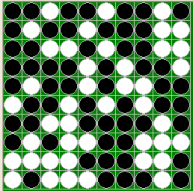 March
17, 2003: A persistent viewer really wanted a 10X10 version
of our Token Flip
puzzle posted a few months ago so here it is. This in spite
of the fact that neither I nor the program, nor anyone else I know of
can consistently solve random games larger than 5X5. If someone
analyzes this darned thing and comes up with an efficient algorithm
for solving, please let me know, so I can mark it complete and move
on.
March
17, 2003: A persistent viewer really wanted a 10X10 version
of our Token Flip
puzzle posted a few months ago so here it is. This in spite
of the fact that neither I nor the program, nor anyone else I know of
can consistently solve random games larger than 5X5. If someone
analyzes this darned thing and comes up with an efficient algorithm
for solving, please let me know, so I can mark it complete and move
on.
| Brook Taylor |
March 21, 2003: Last week's Big Float posting handled basic arithmetic, but brought up questions about how the Windows calculator program (and other scientific calculators) evaluate log, trig, and exponential functions with lots of precision. This Taylor series demo posted today over in the Math Topics section provides a likely answer. Big Float's arbitrarily large real numbers are not yet incorporated, but I believe that we now know how to do it.
March 23, 2003: I added the missing Divide operation to Big Float today, thanks to a suggestion from a viewer. The algorithm divides by making successive approximations to the quotient and checks each guess by multiplying by the divisor. Each guess is the average of the last guess that was too high and the last guess that was too low and it seems to converge fairly rapidly. I guess that this is an application of Newton's Method to solve the equation Dividend ÷ Q - Divisor = 0 for Q.
April 5, 2003: One of my kids bought me "The Code Book" (Simon Singh, Anchor Books) for my birthday last month. It's an excellent history of cryptography - very readable with fascinating codemaking/codebreaking stories from Egyptian hieroglyphics and ancient Roman times through current "Public Key" and "Pretty Good Privacy" cryptography techniques. There are enough examples along the way to make you feel that you might even understand some of it. As a result, I worked this week on the decryption program, Decrypt, and incorporated the revised version into Word Stuff 2. It's better than the original, but still leaves lots of room for improvement. I did add the ability for users to make suggestions to the program to speed it along its decipherment path. Fully automated decryption in the general case, even for simple mono-alphabetic encryptions, is still far from reality. Working on the problem does make you appreciate the achievements of all those high IQ codemakers and codebreakers.
April 6, 2003: I recently upgraded to Delphi 7. One of the advantages of being a substitute teacher at our local high school is access to academic software. I couldn't pass up acquiring D7 Professional for $99! However, there are some downward incompatibilities between D7 and D5 (or earlier, I presume) even if no D7 enhancements are used. I have been trying to make sure that postings here will compile under D5, but missed checking yesterday's Wordstuff 2. Bottom line, if you downloaded the program yesterday, and it does not compile successfully, try downloading again
Eight Queens Wirth finds all 92 solutions and also finds the largest set of solutions that can co-exist on the board without overlapping any other solution (6 solutions). Recently a viewer asked about the smallest set of solutions that could cover all squares of the board. I posted a new version today that tries to answer that question as well. My answer finds 12 solutions that cover the board, I suspect that this is the smallest set. But I haven't proved that it could not be done with 9, 10 or 11 solutions. If anyone has any more information about a definitive answer to this question, please let me know.
Also, in case your great emails don't get answered
right away, we're off on vacation to visit grandkids over Easter. See
you in a week or so. . April 25, 2003: A couple of
years ago I wrote and posted Fibonacci
Sunflowers, which draws primitive sunflowers showing the "double
Gary
Darby "It is not knowledge, but the act of learning, not possession but the act of getting there, which grants the greatest enjoyment. When I have clarified and exhausted a subject, then I turn away from it, in order to go into darkness again." - Karl Friedrich Gauss (Mathematician) "I am enough of an artist to draw freely upon my imagination. Imagination is more important than knowledge. Knowledge is limited. Imagination encircles the world." -- Albert Einstein
To
subscribe or unsubscribe from this newsletter, visit http://delphiforfun.org/newsletter.htm 42,900 home
page visitors since Sept, 2000.
|
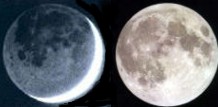 March
27, 2003: Here is a program that calculates the dates of new and
full moons for any past or future range of dates. At a user's
request, I extracted the calculations for this
March
27, 2003: Here is a program that calculates the dates of new and
full moons for any past or future range of dates. At a user's
request, I extracted the calculations for this 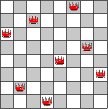 April
8, 2003: About a year ago I posted Eight Queens Wirth, a
program which uses Niklaus Wirth's clever algorithm to solve the "Eight
Queens" problem - place 8 chess queens on a standard 8x8 chessboard in
such a way that no queen threatened another. The program
actually resides as an addendum to the
April
8, 2003: About a year ago I posted Eight Queens Wirth, a
program which uses Niklaus Wirth's clever algorithm to solve the "Eight
Queens" problem - place 8 chess queens on a standard 8x8 chessboard in
such a way that no queen threatened another. The program
actually resides as an addendum to the 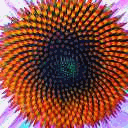 spiral
effect" if seeds are spaced by an angle approximating the ratio
of two consecutive Fibonacci numbers. A sharp eyed viewer just
discovered that one example separated seeds by 31/55 radians instead of
34/55 radians. It's now fixed. If you haven't had a chance to
investigate Fibonacci numbers and their relationship to the "Golden
Ratio", here's a small start.
spiral
effect" if seeds are spaced by an angle approximating the ratio
of two consecutive Fibonacci numbers. A sharp eyed viewer just
discovered that one example separated seeds by 31/55 radians instead of
34/55 radians. It's now fixed. If you haven't had a chance to
investigate Fibonacci numbers and their relationship to the "Golden
Ratio", here's a small start. 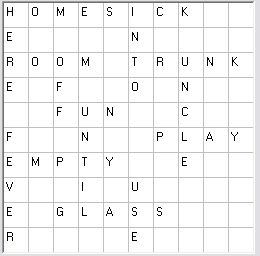 April 29, 2003: Finally, a new program! Not that all the
fixups this month weren't needed, but sooner or later one needs
something new to exercise the "design-side" brain lobes.
April 29, 2003: Finally, a new program! Not that all the
fixups this month weren't needed, but sooner or later one needs
something new to exercise the "design-side" brain lobes.  May
5, 2003: It's been a long while since we posted a new Beginner's
program. Here's one with about 30 lines of user code that finds
the only positive integer that is equal to the sum of the 6th powers of its
digits. The number would fit on a T-Shirt so we'll add it to our
numeric T-shirt series, and call it
May
5, 2003: It's been a long while since we posted a new Beginner's
program. Here's one with about 30 lines of user code that finds
the only positive integer that is equal to the sum of the 6th powers of its
digits. The number would fit on a T-Shirt so we'll add it to our
numeric T-shirt series, and call it  May
11, 2003: Our Olympic tennis coach is faced with the problem of
quickly replacing his team (all received minor injuries in a plane crash!).
He needs to rank the 8 substitutes as quickly as possible. This
puzzle is from the "Puzzling Adventures of Doctor Ecco",
Dennis Shasha, Dover Books. You can read the rest of the puzzle and
and download the program that will let you or the computer solve it over at
May
11, 2003: Our Olympic tennis coach is faced with the problem of
quickly replacing his team (all received minor injuries in a plane crash!).
He needs to rank the 8 substitutes as quickly as possible. This
puzzle is from the "Puzzling Adventures of Doctor Ecco",
Dennis Shasha, Dover Books. You can read the rest of the puzzle and
and download the program that will let you or the computer solve it over at